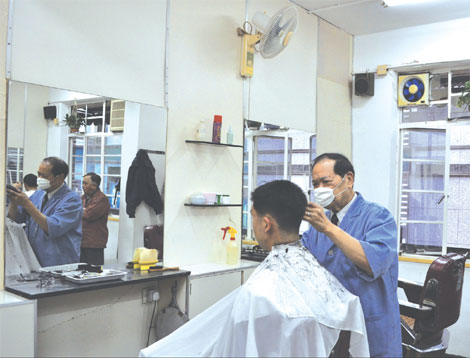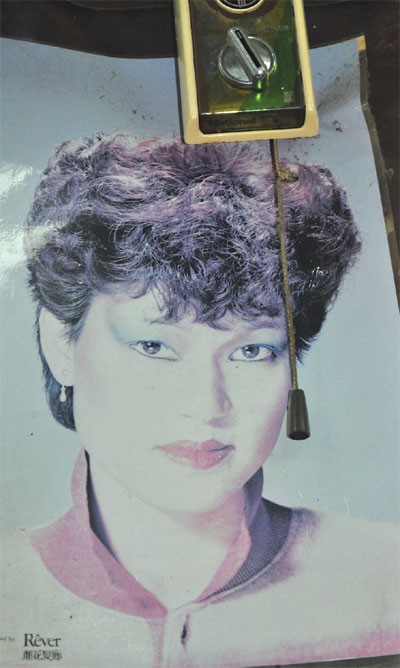A cut above and before the others
Updated: 2010-07-21 07:17
By Yuanni Chen(HK Edition)
|
|||||||
|
A barber cuts hair in Shanghai Ambassador Beauty Saloon in Causeway Bay. All barbers in the old Shanghai barber shop are in their 60s or 70s. Provided to China Daily |
|
For more than 50 years, the shop has been using almost the same tools. Provided to China Daily |
Traditional craftsmen clinging to what the young would call very 'retro' haircuts, Shanghai-style barbers are an aging and disappearing Hong Kong breed. Yuanni Chen reports.
Hong Kong columnist Lim Chin Keong once wrote about his experience at Hong Kong barber shops: If you ask for a Donald Tsang (Hong Kong's Chief Executive) look, you can only get a Tsui Sze Man (a deceased local publisher) look, which will cause you to scream: "Why? Why me?" But if you go to an old Shanghai barber shop and ask for a Donald Tsang look, you can get what you want.
The old Shanghai barber shop he mentioned is Shanghai Ambassador Beauty Saloon in Hong Kong's Causeway Bay. It has Shanghai in its name not only because most barbers in the shop are from Shanghai, but also because Shanghai barber shops dominated the local hairdressing business for more than 20 years, from the 1950s to the 1970s. The name "Shanghai barbershop" used to connote fashion for high-end consumers.
The situation has changed since the mid-1970s, when new-style barber shops appeared. Shanghai Ambassador Beauty Salon is one of the few Shanghai barber shops remaining in Hong Kong, but the future of the business is under threat as it faces the challenge of adapting itself to the changing times.
As 75-year-old Ng Kai Ming, one of the masters in the shop, recalled, there used to be about 20 Shanghai barber shops in Causeway Bay alone in the 1970s. Currently, Shanghai Ambassador Beauty Salon may be the only survivor that can afford to have a shop in the expensive neighborhood. Most of the remaining shops are in Sham Shui Po district, where rents are among the lowest in Hong Kong.
Located on the second floor of an old building on Lan Fong Road, Shanghai Ambassador Beauty Salon has a history of more than 50 years. Sixty-year-old Cheung Kuai Lung is the current boss and the youngest barber in the shop. The other four barbers are in their late 60s or 70s. Wearing a blue uniform with black tie, they look professional and spiffy. "In traditional Shanghai barber shops, all barbers are required to wear a white shirt, white coat and black bow tie. The tidiness and professionalism is why in the 50s, Shanghai barber shops replaced old-fashioned Guangdong barber shops and dominated the business," Cheung said.
In the early 50s, a lot of Shanghai people fled the mainland as the Communist Party took over Shanghai. Ng is one of them. As Ng recalled, Shanghai in the 1940s was a more developed and modern city than Hong Kong. When the barbers arrived in Hong Kong, they brought professional services and new hairstyles that soon made Shanghai barber shops the fashion hub of the city. "We are the classical Shanghai style. People from high society love our hair cut," Ng said.
The classical Shanghai style Ng mentioned is the short, neat haircut that was often seen among government officials, returned overseas Chinese and Chinese entrepreneurs in Shanghai in the 1930s.
For more than 50 years, Shanghai Ambassador Beauty Salon has been using almost the same tools, following the same cutting process and cutting the same hairstyle. Stepping into the shop, the old chair, the posters of pop stars in the 1970s, the electronic fans, the porcelain basin, and all the rolling knives, razors and other trimming tools make people wonder whether this is an antique store.
All these 30- or 40-year-old tools are still in use. After a greeting, the master will start to work with these tools, cutting, shaving and drying. A package of haircut, shave and shampoo takes about one hour - precise, clean and polite.
Shaving is one of the popular services the shop offers. Tony Wong, a customer who loves the shop, said, "You've got to come here if you want to get a real clean shave. You can sleep and relax on the chair while the master is working on you. If feels super."
If you want some trendy haircut, you will not feel super after visiting the shop. Lim Chin Keong made fun of its hairstyle, saying no matter whether you sat in the shop in the 1990s or were to walk in now in the 21st century, you would walk out with one of three hairstyles: the Ying Cheung, the Ng Cho-Fan and the Chou Tat-Wah, all Cantonese movie stars in the 50s and 60s. If you ask for a younger look, you can only get as young as Wu Fung, a popular TV and movie star in the 1980s, and you need to pay extra.
Asked about this, Ng said, "That's what we learned from our masters. It looks simple, but it's hard to cut it well. These styles are classical styles for people in high positions. We don't do weird hairstyles like other beauty Salons these days."
That's the main reason the business is under threat. Though people like Rita Fan, the first president of the Legislative Council, and Joseph Lau, a Hong Kong billionaire, once went to the saloon, few young people go there. Most customers are men in their 60s or 70s who have visited the saloon for several years.
Forty-year-old Tony Wong is one of the younger customers. He comes to the shop about every two months from Kowloon. "I like the friendly and nostalgic feeling here," Wong said.
Women customers, a major source of income for most beauty salons, are rarely seen in the shop. The salon has two hair-perm machines bought 40 years ago, but they are seldom used in recent years, as the barbers in the salon know only the hairstyles of women pop stars in the 70s, which are still posted on the wall.
Bonnie Kwan, a senior stylist for Hair, which has one 6,000-square-foot chain store in Festival Walk, said she thought the Shanghai barber shop was always for old people. When she heard most of the salon's customers are men, she said, "that must be so boring." Most of her customers are housewives who are changing their hairstyles constantly and spending thousands on hair every month. She charges HK$420 for a cut, while the director of the store charges HK$1,400. At the Shanghai Ambassador Beauty Salon, all barbers charge HK$96 for a cut.
"We have 40 to 50 customers a day in general, and the business is just enough for everyone to make a living," Cheung said. "I'm not very optimistic about the future. The old barbers are dying. Young people are more interested in learning fashionable hairdressing. With no new people to join, I'm not sure how long the business will continue."
|
The posters of pop stars in the 1970s still hang on the walls of the shop. Provided to China Daily |
(HK Edition 07/21/2010 page4)


